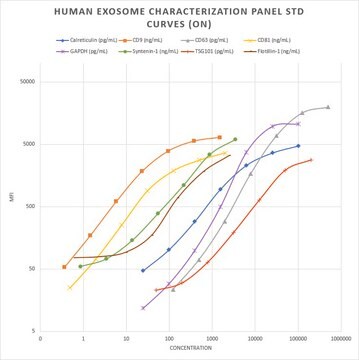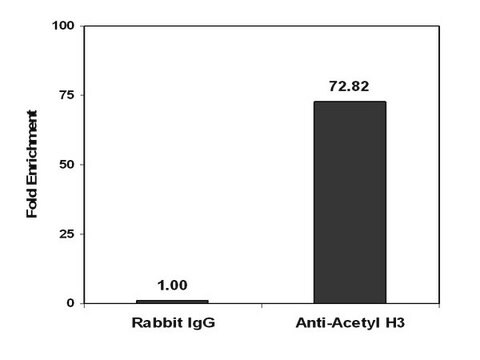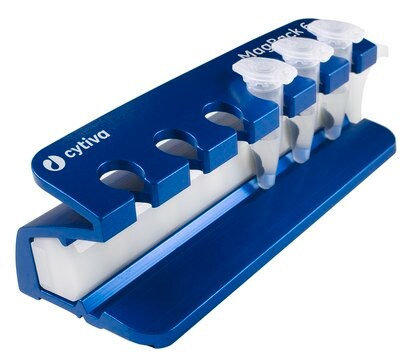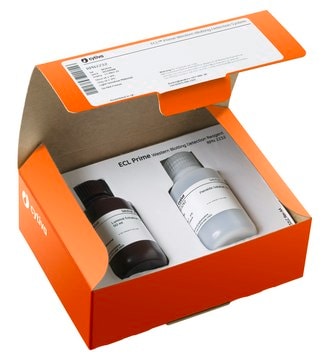HEXSM-170K-BKPMX
MILLIPLEX® Human Exosome Characterization Panel
for analysis of multiple analytes isolated from serum, plasma and tissue culture supernatants
About This Item
Produits recommandés
Niveau de qualité
Gamme de produits
Milliplex®
Espèces réactives
human
Conditionnement
pkg of 96 wells
assay range
standard curve range: 0.4-1,500 ng/mL
(CD9)
standard curve range: 0.5-2,000 ng/mL
(CD81)
standard curve range: 122-500,000 pg/mL
(CD63)
standard curve range: 1: 0.6-2,500 ng/mL
(Flotillin)
standard curve range: 1: 0.9-3,500 ng/mL
(Syntenin)
standard curve range: 24-100,000 pg/mL
(Calreticulin, GAPDH)
standard curve range: 49-200,000 pg/mL
(TSG101)
inter-assay cv: <20%%
intra-assay cv: <10%
Technique(s)
multiplexing: suitable
Méthode de détection
fluorometric (Luminex® xMAP®)
Description générale
Each MILLIPLEX® kit includes:
- Quality controls (QCs) to qualify assay performance
- Comparison of standard (calibrator) and QC lots to a reference lot to ensure lot-to-lot consistency
- Detection antibody cocktails designed to yield consistent analyte profiles within panel
Panel Type: MAGNETIC Circulating Cancer
Spécificité
Application
- This is an overnight assay.
- Each assay requires 25 µL per well of isolated exosomes.
- Argonaute-2 (Ago2) is a qualitative assay with the MCF7:IGF-1 Cell Lysate included as a control. All other analytes are for quantitative analysis.
- To test purity of EV preparation, the MILLIPLEX® Human Apolipoprotein 6-Plex Panel (Cat. No. APOMAG-62K) can be used.
- To asses the functional component of EVs, the MILLIPLEX® Human Cytokine/Chemokine Growth Factor Panel A (Cat. No. HCYTA-60K), Panel B (HCYTB-60K), and Multi-Species TGFβ Panel (Cat. No. TGFBMAG-64K-03) can be used.
- Following sample collection and preparation, exosomes can now be isolated and lysed according to your lab’s established protocol. We recommend Cell Signaling Lysis Buffer (Cat. No. 43-040).
- Each lab may use its preferred lysis buffer but must predetermine that the assay will not be negatively affected by the lysis buffer.
Conditionnement
Stockage et stabilité
Autres remarques
Informations légales
Clause de non-responsabilité
Mention d'avertissement
Danger
Mentions de danger
Classification des risques
Acute Tox. 4 Dermal - Acute Tox. 4 Inhalation - Acute Tox. 4 Oral - Aquatic Acute 1 - Aquatic Chronic 2 - Eye Dam. 1 - Skin Irrit. 2 - Skin Sens. 1 - STOT RE 2
Organes cibles
Respiratory Tract
Code de la classe de stockage
10 - Combustible liquids
Classe de danger pour l'eau (WGK)
WGK 3
Certificats d'analyse (COA)
Recherchez un Certificats d'analyse (COA) en saisissant le numéro de lot du produit. Les numéros de lot figurent sur l'étiquette du produit après les mots "Lot" ou "Batch".
Déjà en possession de ce produit ?
Retrouvez la documentation relative aux produits que vous avez récemment achetés dans la Bibliothèque de documents.
Notre équipe de scientifiques dispose d'une expérience dans tous les secteurs de la recherche, notamment en sciences de la vie, science des matériaux, synthèse chimique, chromatographie, analyse et dans de nombreux autres domaines..
Contacter notre Service technique












